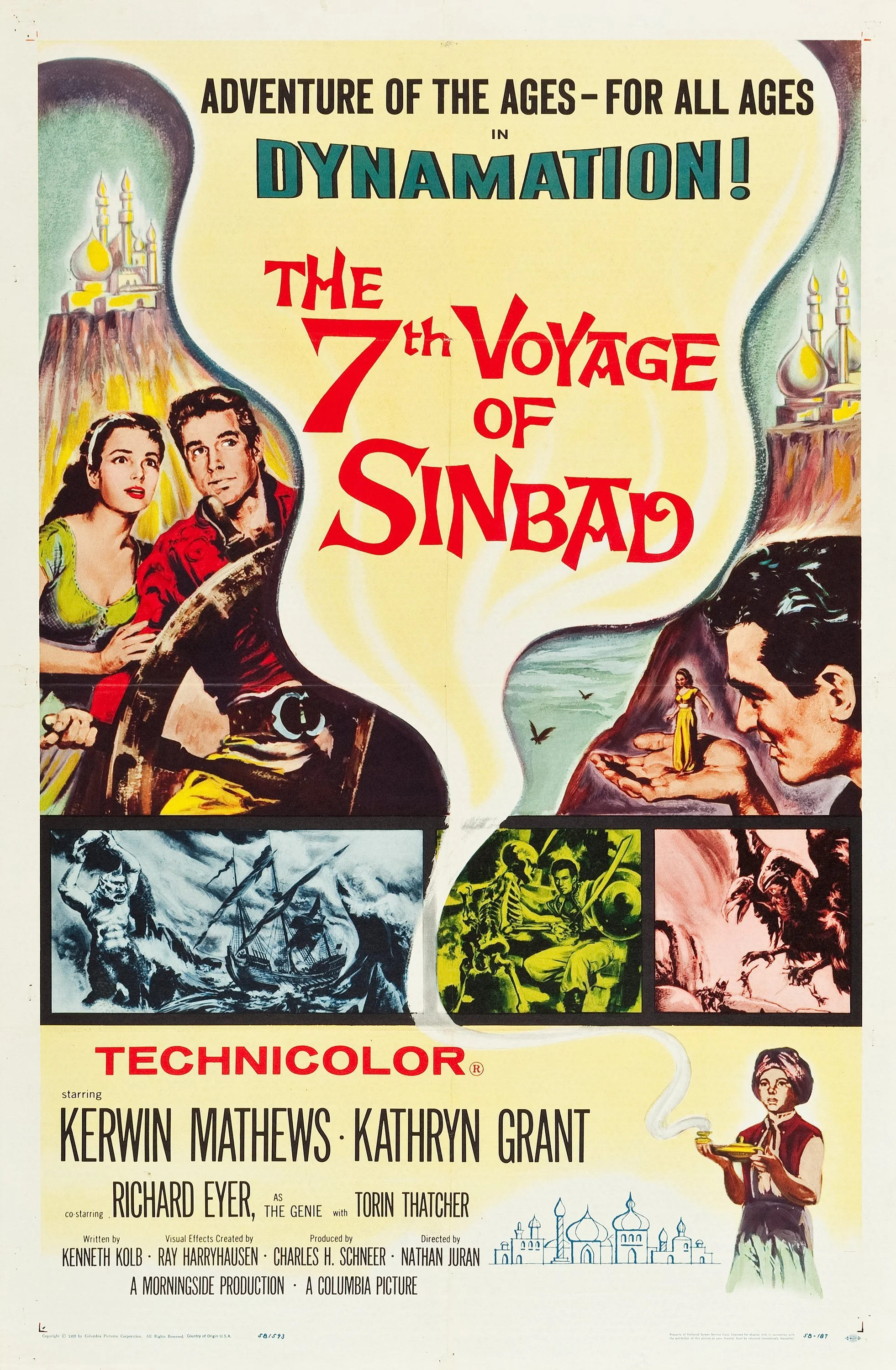The 7th Voyage of Sinbad (1958)
I promised something more fun after the harsh reality of Shoes (1916), but before we talk about The 7th Voyage of Sinbad (1958), we need to talk about a man named Ray Harryhausen.
Ray Harryhausen and stop-motion animation
For those of younger generations, he may be famous only for his surname, which serves as the inspiration for the sushi restaurant from Disney and Pixar’s Monsters, Inc. (2001). It’s a delightful little send-up, but there’s more to the story.
For a significant chunk of the twentieth century, Ray Harryhausen was considered one of the brightest, most creative, and most talented animators and special effects artists working in the film industry. He specialized in stop-motion animation, a design that is unfortunately widely associated with the Rankin Bass Christmas films of the 1960s and 1970s that were never good but that for some reason we still keep watching (Abominable Snowman, anyone?). Harryhausen’s designs are…I’ll be diplomatic here and just say “better.” A lot better.
Ray Harryhausen’s creatures are detailed, creative, and thoughtfully designed, and though they definitely have the “stop” that is the defining characteristic of stop-motion animation, when a Harryhausen cyclops is bearing down on you? Yeah, you feel it.
This brings us to today’s movie, The 7th Voyage of Sinbad (1958).
The 7th Voyage of Sinbad (1958)
The first in a trilogy of Sinbad adventure movies (though the other two would not be released for another fifteen years and would star none of the original cast), The 7th Voyage of Sinbad is loosely based on tales from the Sinbad the Sailor story cycle and incorporates many classic elements of both epic hero stories and fairy tales. A sleeper hit in its day, it continues to be well received by modern audiences.
Shot with Ray Harryhausen’s proprietary Dynamation (“the new miracle of the screen”!), The 7th Voyage of Sinbad largely takes place on a remote island populated by classic Harryhausen creatures, which our heroes must battle in order to find the treasure, save the princess, free the genie, AND defeat the evil wizard (long day for Sinbad and his gang).
The story begins with the magician Sokurah (Torin Thatcher) running for his life from a cyclops on the island of Colossa. Sinbad (Kerwin Mathews) and his crew rescue Sokurah, who lost his magic lamp (because of course there’s a magic lamp) in the struggle. Sinbad refuses to take him back to the island, and they set sail for Baghdad, where Sinbad is set to marry Parisa (Kathryn Grant), the princess of a neighboring realm.
When Sokurah can’t convince Sinbad to return to Colossa, he sneaks into Parisa’s room and shrinks her down to just a few inches tall. He then tells Sinbad that he can set her right if he makes a magic potion, but he requires an egg from a Roc (a magical bird) that only lives on Colossa. What an unbelievable coincidence! Sokurah even goes so far as to provide the design for a giant crossbow that Sinbad and his crew can use to defend themselves on the island.
So, Sinbad and Sokurah return to Colossa, taking with them Sinbad’s second-in-command Harufa (Alfred Brown) and a gang of sailors culled from Baghdad’s prisons, because surely that won’t go wrong.
Shortly into the voyage, it goes wrong, and the convicts mutiny. But when they hit a bad storm, the sailors decide that perhaps sacrificing the only experienced seaman on board isn’t the best idea. They free Sinbad, who manages to save everyone.
When they get to the island, it all kicks off: a cyclops, a nesting Roc, a dragon, a sword-wielding skeleton. A lot of the rest of the film is a little looser plot-wise, and much of the runtime is spent just interacting with Harryhausen’s creatures. I’m honestly not complaining though—it’s really cool to watch. What’s NOT cool to watch (spoiler alert) is Sokurah murdering Harufa, who had, at this point in the film, become my favorite character. Bad wizard!
Eventually, our heroes discover that Sokurah’s lamp contains a genie, a little boy named Barani (Richard Eyer) who longs for his freedom. When Sokurah captures Parisa and absconds with her back to his underground castle, Barani helps Sinbad locate them and get past Sokurah’s obstacles. Sokurah works his magic to fix Parisa, but when Sinbad won’t return the lamp, Sokurah sets a guard skeleton (because what kind of self-respecting evil magician WOULDN’T have one of those?) on him. Spoiler alert, but Sinbad wins the day (huzzah!). Sinbad and Parisa free Barani and escape the castle, continuing to fight against Sokurah’s dragon.
And then we realize just how pathetic this evil wizard is. Sinbad’s crew assembles the giant crossbow (y’know, from the plans that Sokurah GIFTED to Sinbad—THAT crossbow) to shoot down the dragon. And how does Sokurah die? Crushed to death under his dragon, which was killed by his own crossbow. Serves him right for killing Harufa. Bad, bad wizard!
The 7th Voyage of Sinbad (1958) and Ray Harryhausen’s legacy
While I wouldn’t call this a new favorite for me, I highly recommend picking it up if you’re looking for something a little adventurous, a little magical, a little campy, and super visually creative. The designs may look a little dated now, in an era that has seen Peter Jackson’s special effects, but remember that only fifteen years prior to this film we were impressed by stagehands throwing stuffed animals onto actors from off screen in Cat People. In particular, the scene where Sinbad fights the skeleton on top of the wizard’s spiral staircase to nowhere (which, really, why does he have one of those?) actually aged pretty well. In fact, that scene was such an audience favorite that Harryhausen used a more large-scale production of it for Jason and the Argonauts (1963).
Not a top favorite, but I certainly wouldn’t poo-poo it if given the chance to watch it again. Now if you’ll excuse me, I have to go mourn Harufa.
Camille






